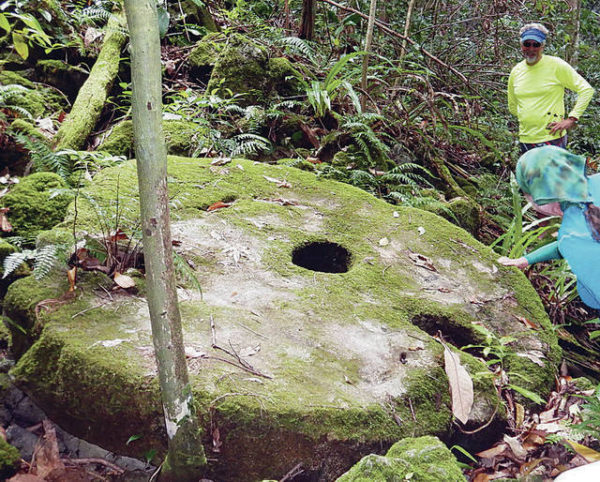Published in the Ocean Watch column, Honolulu Star-Advertiser © Susan Scott
March 3, 2018
YAP, FEDERATED STATES OF MICRONESIA >> My snorkeling group has flown from Palau to Yap, island nations in the western Pacific about 250 miles apart. Yap is famous for its manta rays, and we’ve seen several of these graceful fish as they approach a reef where cleaner wrasses nibble pests off their skin.
Cleaner wrasses are 5 to 6 inches long and make their living eating parasites off other fish. Pairs of wrasses set up cleaning stations and wait for clients to visit. When a fish arrives, it hovers motionless as the little wrasses work it over, even entering mouths and gills to get the goodies.
 A piece of stone money, probably 10 feet across,
A piece of stone money, probably 10 feet across,
abandoned on a hillside in Palau.
©2018 Susan Scott
We didn’t see the wrasses actually cleaning the rays because our Yapese guides are careful that visitors don’t scare the much-loved mantas, which also use the area for meeting and mating. But we did float above as several 9- to 10-foot-wide rays glided through the water below on their approach to the spa.
It’s a thrill and a privilege to witness such a spectacle of nature, but even so, mantas are only one extraordinary marine story here. There’s also the money.
Human history is loaded with tales of people going to great lengths to mine, haul and steal items considered valuable, be they paper, beads, shells or minerals. Yap’s story of stone money, however, is exceptional.
It starts in Palau, where geologic forces have pressed limestone into crystalline calcite, a sparkling substance hard as marble. In ancient times, people from Yap sailed to Palau in voyaging canoes, and lived in caves for years while they shaped pieces of this dense rock into rounds for currency.
Some stones are 10 feet in diameter and weigh tons, because the bigger the piece, the more valuable it was. [Not entirely accurate. See correction in March 10th column.]
The quarries were on steep jungle hilltops, making the transfer to the shoreline hazardous. To help the descent, the money makers cut a hole in the center of each piece and inserted a wooden pole. At the waterline the stone was hoisted onto a raft and towed behind the canoe to Yap.
Given Pacific Ocean crossings, countless lives were lost in these endeavors. The miners who made it home, however, were rich, and sometimes named the stones after those who died in the undertaking.
Yap’s stone money system was struck by inflation when in the 1800s an Irishman named David O’Keefe began chartering his schooner to sail Yapese men and their money between Palau and Yap.
One currency in Yap today is the U.S. dollar, but the people of Yap still value their original economic system, displaying family wealth in front of their homes, and village capital in rows of stone money banks.
I highly recommend a visit to Yap. Besides meeting some of the friendliest people on the planet here, it’s the only place where money is as big as manta rays.